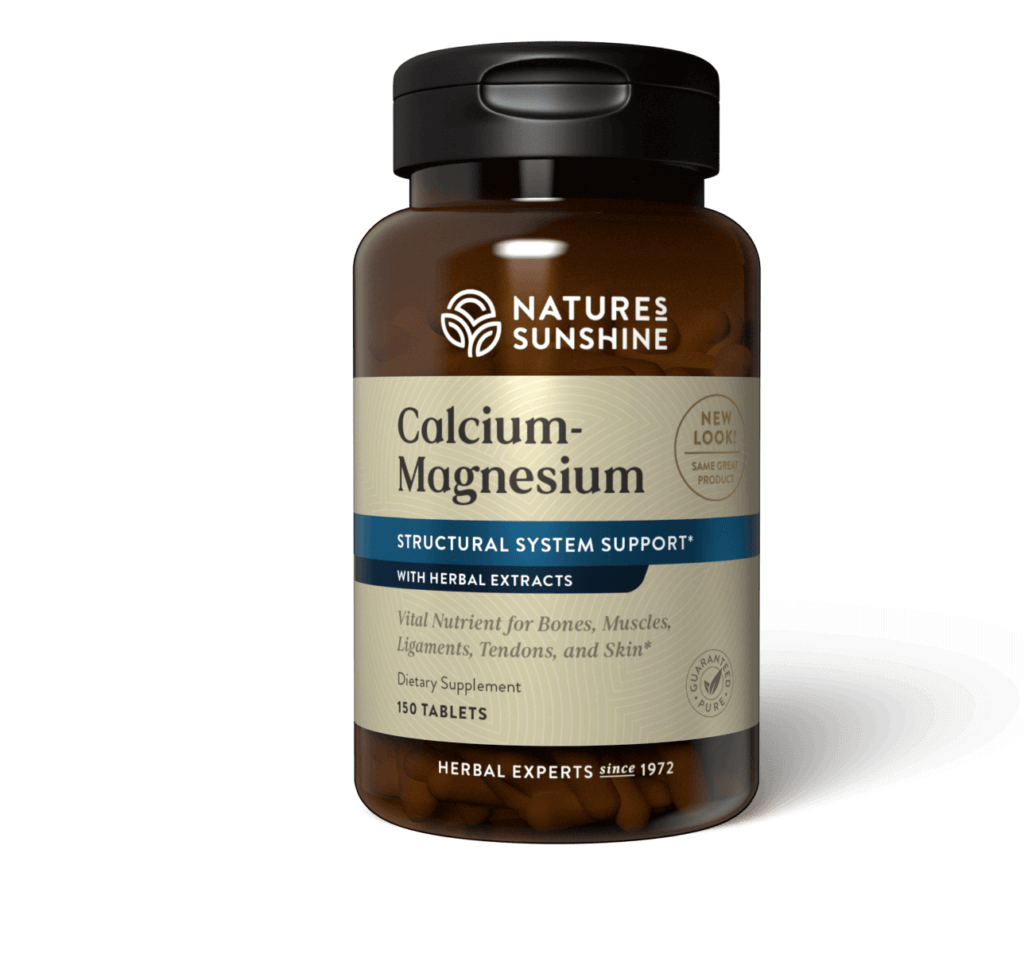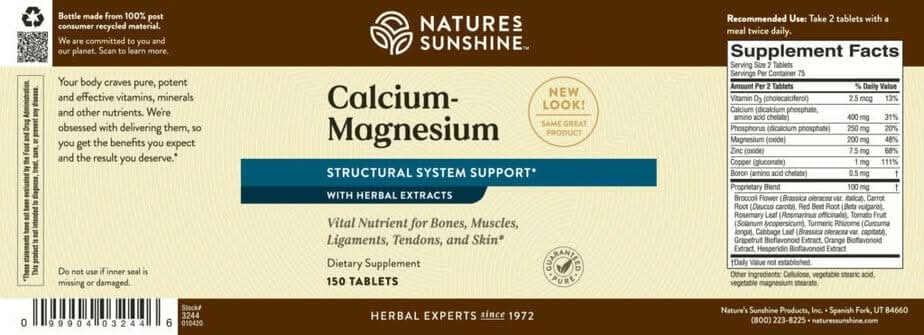The Herbs Place
Calcium - Magnesium, SynerPro (150 tablets)
Calcium - Magnesium, SynerPro (150 tablets)
Couldn't load pickup availability
Nature's Sunshine's SynerPro Calcium - Magnesium contains calcium, magnesium, phosphorus, vitamin D, zinc, copper, and boron in an antioxidant base of dehydrated broccoli, carrot, red beet, rosemary, tomato, turmeric, cabbage, Chinese cabbage, grapefruit, and lemon bioflavonoids and hesperidin. No sugar, starch, artificial colors or flavorings, and as with all their products - yeast free!
The body is constantly using calcium from the diet to replace old bone tissue with new tissue. Calcium is required in the bones to help maintain health, strength and hardness. But it does not work alone. Magnesium is an essential component of bone and is also necessary for calcium, vitamin C and phosphorus metabolism. Other critical minerals and vitamins are manganese, phosphorus, vitamin A (beta-carotene), vitamin C and vitamin D. Many of these elements work synergistically to form strong bone matrices and cartilage.
This team work is also very evident in the circulatory system. Calcium and magnesium are found in all cells, especially the heart and artery muscle cells, as ions. Calcium stimulates the muscle fibers to tense and contract, while magnesium acts as a control mechanism. The heartbeat is actually a series of contractions and relaxations. Calcium is part of the calcium/sodium pump that is said to maintain normal artery musculature. Magnesium helps to regulate the amount of calcium that enters the cells and acts as a tempering influence. This characteristic has caused some to term magnesium the anti-stress mineral. With too little magnesium present, calcium and sodium may flood the cells. This may result in constriction and/or spasm of the heart and circulatory system.
Calcium
Calcium is the most abundant and one of the most important minerals in the body. About two percent (two to three pounds) of the body weight is calcium. Perhaps surprisingly, the Department of Agriculture lists calcium as one of the four most missing nutrients in the American diet.
Approximately 99 percent of that calcium is present in the bones and teeth. Although bones appear to be solid and inert, they are not. Calcium moves in and out of the bones in a complex series of reactions regulated by hormones. Each year, approximately 20 percent of the calcium in bones is removed and replaced. Some hormones work to ensure that there is enough calcium in the blood. This means that calcium is readily available to the bones, as well as to nerves and muscles. In the bone matrix, calcium is found as calcium phosphate, and phosphorus is also an essential part of maintaining skeletal health. In 1919, Sir Edward Mellanby found a compound in cod liver oil that helped in rickets, a bone weakening condition notable in young children. The substance became known as vitamin D. Vitamin D is valued for its ability to increase the amount of calcium deposited in the bones.
However, all calcium is not found in bones and teeth. Calcium also helps to regulate body processes such as normal behavior of nerves, muscle tone and contractility, and blood coagulation. It helps to transport impulses of nerves from one part of the body to another. Calcium is also a key to the activation of certain enzymes and the stability of the brain and muscles.
To ensure that you're receiving enough calcium in your diet, increase your intake of calcium-rich foods such as dairy products, leafy green vegetables, seeds, beans and citrus fruits. Herbs such as kelp and valerian are good herb sources. Avoid calcium-blockers, such as oxalic acid and phytic acid, which can combine with calcium to form insoluble salts. And make sure you are getting enough companion nutrients, like vitamin D and vitamin C. Also, exercise regularly, since bone is similar to muscle in that it becomes stronger by regular use and exercise.
Magnesium
Magnesium performs many functions in the body, and it is also important in plant metabolism. Magnesium is an essential part of the chlorophyll molecule. A substance similar to that which forms chlorophyll in plants binds with iron to form heme in the blood. In the body, magnesium activates ATP, the energy molecule, to release energy from food and give it to cells. When we eat green plants, magnesium from chlorophyll helps ATP to free the energy from the plant.
More than 300 enzymes require magnesium in order to function properly. Magnesium functions as a coenzyme for building and maintaining protein for DNA and RNA synthesis. It is also important in cell maintenance, growth and repair.
Seventy percent of the magnesium in the body is found in the bones. The other 30 percent is found mainly in the soft tissues and blood. More magnesium than calcium is found in the muscle tissues. The brain also has twice as much magnesium as any other body tissues.
Magnesium is also necessary for the metabolism of vitamin C, phosphorus, potassium and sodium. It helps to maintain the acid/alkaline balance in the body and is part of the salty, electricity-conducting "soup" that bathes and permeates body cells.
Some common foods that contain magnesium include vegetables, nuts, beans, legumes, whole grains, Seafoods, dairy products, bitter herbs and fruits like figs, lemons and grapefruit.
Ingredients
Four Tablets contain the following ingredients in the SynerPro concentrate base.
| Amount per 4 Tablets | ||
| Vitamin D | 200 I.U. | |
| Calcium (amino acid chelate, di-calcium phosphate) | 800 mg. | |
| Phosphorus (di-calcium phosphate) | 500 mg. | |
| Magnesium (oxide) | 400 mg. | |
| Zinc (oxide) | 15 mg. | |
| Copper (gluconate) | 2 mg. | |
| Boron (amino acid chelate) | 1 mg. | |
| Proprietary Blend | 100 mg. |
Proprietary Blend
Broccoli Flower (Brassica oleracea)
Carrot Root (Daucus carota)
Red Beet Root (Beta vulgaris)
Rosemary Leaf (Rosmarinus officinalis)
Tomato Fruit (Solanum lycopersicum)
Turmeric Root (Curcuma longa)
Cabbage Leaf (Brassica oleracea)
Chinese Cabbage Leaf (Brassica rapa)
Grapefruit Bioflavonoid Orange Bioflavonoid Hesperidin (Bioflavonoid)
Label Recommendation
Take two tablets with a meal twice daily.
References Bricklin, Mark. Calcium, A Miracle in Overalls, Prevenlion, August 1977 Donald, Alan. "Calcium; New Discoveries of Its Protective Effects" Bestways, November 1986. Facltcn, Sharon. The Complete Book of Minerals. EMMAUS, PA: Rodale Press, 1981. Null, Gary. The Complete Guide to Health & Nutrition. New York: Delacorte Press, 1984. The National Research Council, Recommended Dietary Allowances, 9th ed. Washington, D.C.; National Academy of Sciences, 1980.




